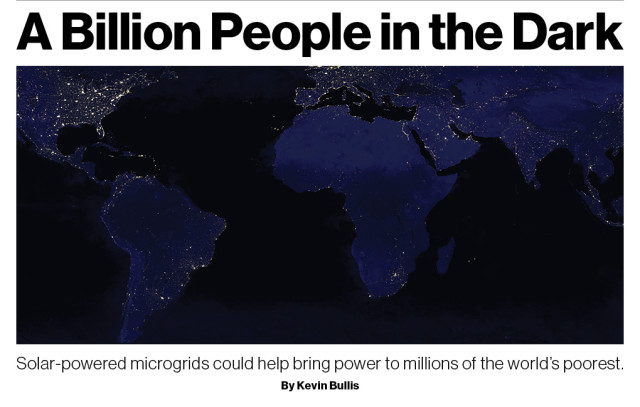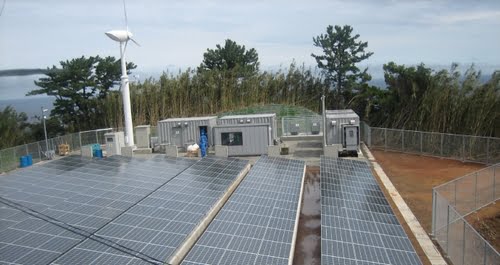“Is it a fact – or have I dreamt it – that, by means of electricity, the world of matter has become a great nerve, vibrating thousands of miles in a breathless point of time?”― Nathaniel Hawthorne.
Not everyone in India is experiencing this magic. 33% of all Indian households (about 80 million households, or over 300 million people) and 45% of rural households do not have access to electricity. What if there is an alternate way to the electric supply? Supply of electric in rural areas is imperfect and discontinuous. At this point of time micro grids can provide to larger crowds in rural areas. This will be a light bulb moment for the private companies.
 Microgrids:
Microgrids:
Microgrids are modern, small-scale versions of the centralized electricity system. A host of private companies have, thus, in recent years set up microgrids-solar, wind, biomass or diesel plants, or a combination of these- to meet the shortage. Most common are solar plants or solar biomass and solar diesel hybrids. They achieve specific local goals, such as reliability, carbon emission reduction, diversification of energy sources, and cost reduction, established by the community being served.

According to bussinesstoday statistics, over 22% of the world’s population denied power lives in India, with 19,300 villages yet to be electrified. Even where grid power is available, supply is invariably irregular, especially in the rural areas. The business opportunity is huge. Smart microgrids are an ideal way to integrate renewable resources on the community level and allow for customer participation in the electricity enterprise. They form the building blocks of the Perfect Power System. It is a relatively untapped market and should be attractive for new entrants.
Challenges:
Rich villagers use diesel generator sets, which come in all shapes and sizes, to cater to their domestic and farming needs, while the poorer ones have to make do with a mix of wood, diesel, kerosene and batteries, mainly to watch television. The lantern/box is charged at the solar plant during the day.
Village residents cannot pay any high prices. But the heavy investment during installation naturally raises the price of power supplied. So the companies decided to go for the prepaid packages to the residents and also supply power to as many towers as possible. There need to be many cable cuts in highways to the villages, for doing this the company needs to get permission from the local authority which is difficult to obtain.
There are grants released by the central government and also by national banks. But there is a loophole here because many companies cannot offer the guarantees and securities which are required to get access to these loans. To encourage the entrepreneurs to utilise the opportunity there should be soft loans offered.”The government should facilitate soft loans at concessional rates. The ideal mix would be 30% subsidy, 50% soft loan and 20% investment by the entrepreneur.” says G. Prasad, Director in the Ministry of New and Renewable energy.

Prepaid Tech:

Private companies to retain its customers started using prepaid basis. The villagers are given power boxes which are charged can work six to eight hours. The prepaid package which one company is offering is Rs 250 to Rs 300 per power box per month which is economical.
Using the loans, Naturetech developed SMS-based prepaid meter which gives an SMS after the credits usage but the initial wiring and switches cost need to be paid by the consumers only. Simpa Networks proceeded to a step further stating consumers can become owners of the plant and need not pay anything at all,but manage its maintenance .However, they need to Rs25 per day for 28 months and then they can become the owners.

Microgrids have attracted substantial funding. Each company is responding to different opportunities. Simpa Networks so far raised $5.9 million and equity. However they cannot utilise all the opportunities they get through because they need to make the company stronger and secure. Merging electricity and telecommunications to create a dynamic infrastructure that enables today’s electronic appliances and end-use devices to automatic all exchange electricity and information with the bulk power distribution grid.
Acceptance:
The one solution is that currently erratic supply should improve. This does not turn up in a short period. And also many villages in India are not covered by central government. The privately-run companies do not come up to take the challenge of setting up the power grids because they are scared of the government actions and also there are constant talks about developing this sector and grid expansion. The whole grid expansion should be as decentralized as possible. A state funded high quality micro grids can be developed where a private sector can play a vital role. Since there is a state funding, private companies can be selected through competitive bidding. And also the distribution network and infrastructure should be designed in such a way that the solar panels can also be connected to the future grids.

According to TechRepublic, some utility providers are becoming less reluctant, as well. For example, Germany‘s utilities changed their business models and provided microgrids, instead of having to face criticism for not allowing them; and in the aftermath of Hurricane Sandy, New York has been looking at their energy policies to find the best ways to move forward and increase the resiliency of energy. The US has had one central utility with a monopoly on electricity, but that is changing, quickly. What’s more is electricity prices are always increasing, so renewable energy technology is now achieving “grid parity” in certain places. When we compare our economy to the developed nation US, we need to definitely use the opportunity to widespread the knowledge about micro grids.
India is a developing nation. Although the primary sector for India is agriculture, we cannot rely on the weather for the whole year. Many villages in India do not have continuous power supply. There will be no water supply unless the motor which runs on electricity works. When agriculture sector looks up, benefits will fall on other sectors too. So Microgrids in India will definitely take the economy to the next stage. The reliability of the power grid is not even 90% now. There is a hike in oil prices and coal, and even the infrastructure of power plants needs to be changed. It’s time to utilise the service sector to utilise the smart-grid technologies to increase the reliability and efficiency of the grid. Utilising all the sectors in all possible ways, we can move into better power future.
By Pavani Chennamasetti































